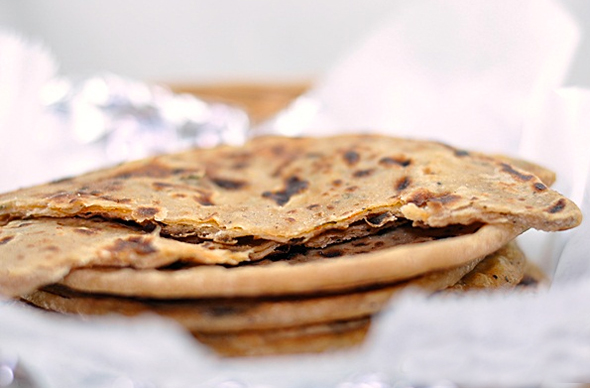Mama’s Punjabi Recipes: Loon Mirch da Parantha (Salt ‘n’ Pepper Crispy Flatbread)
If you want to make a true Punjabi really happy about a meal, just tell him or her that you’ll be serving hot paranthas and they will come right over. They might even invite themselves over if they smell the paranthas being cooked on a hot tava (flatplate). There’s just something about the smell of a hot parantha becoming crisp with just a little sizzle as it fluffs up, that is undeniably inviting.
The word parantha comes from parat (turn over) and atta (flour) and it is pronounced in various ways across India and other places where Indians have settled, like Mauritius, Burma and Malaysia.
Paranthas are thicker and more substantial than chappatis or rotis because of using more dough – which is rolled twice – and coating with ghee (clarified butter) or oil while cooking. There are at least 50 types of often-made paranthas but many more could be made with different ingredients and a little imagination. The secret is to know how to stuff the atta and then cook it on the tava without the dough falling apart.
A homemade Punjabi parantha is usually 8 to 10 inches round and nearly ¼ inch thick. It is made of twice-rolled dough, with a little dab of oil and then cooked on each side till there is a crispy, golden brown top layer, which can only happen when you coax the dough to actually puff up and NOT press down hard on it while cooking. Then the crispy side is coated with some butter or oil and served piping hot.
And the easiest parantha to make is the loon-mirch (salt and red pepper with a pinch of ajwain (carom seeds)) one which is a favorite of little kids who hate to eat crumbling pieces of stuffing falling out while they tear the bread apart. It was a favorite of my kids who would often sit side-by-side at the kitchen table and eat the parantha with a fried egg on top and a little chilled butter on the side! They loved the crispy edges of the parantha and the eggs!!
Ingredients:
500gm kanak (gehon) ka atta (wheat flour)
2 tbsp tael (olive oil or vegetable oil)
1 1/2 cups pani (water)
1/4 tsp namak (salt) per parantha
1/4 tsp mirch (red pepper) per parantha
1/4 tsp ajwain (carom seeds) per parantha – optional
Directions:
1. Pour the atta into a bowl (stainless steel is best); pour in the water a little at a time and knead into dough. Make sure that the dough is not hard but not too soft. It shouldn’t stick to the hands or the bowl. Cover and set the dough aside for 30 minutes.
2. Grease your hands with a dab of oil. Pinch off a small amount of dough and roll it in the palms of your hands into a 2-inch round paada (ball).
3. Coat the counter top with some dry atta, then roll the ball out with a pin into a 4 inch disc.
4. Throw in the salt and pepper, then gather off the ends off the dough in pleats with a pinch and then roll into a ball again. The ajwain is optional but helps with digestion and gives additional flavor.
5. Carefully roll out the ball into an 8 to 10 inch disc, ¼ inches thick, trying not to put a tear in the dough.
6. Put a small dab of oil on a hot tava (hotplate or skillet) and place the flattened disc on. When it puffs a bit and turn color, turn the pancake over. Turn the heat to medium low. Put another dab of oil on the tava and then turn it over again till it is fully cooked. A well-made parantha will actually puff up!
7. These paranthas are best served hot with butter, plain yogurt, daal (lentils) or sabzi (vegetables).
MAMA’S TIP OF THE WEEK
REMOVE THE SEEDS FROM EGGPLANT WHEN MAKING BHARTHA
There are only a few types of ways to make baingan bhartha (mashed sautéed eggplant), but there are two things that can really destroy the enjoyment of the dish. One is when the eggplant has been shredded and there are still long stringy filaments that run through it.
And the other is when there are just too many seeds left in the finished dish and you bite into them while eating. Depending on the way that the eggplant is roasted, make sure to take the extra time to remove the seeds before shredding. It is a little time consuming but the final result is in the tastiness of the dish.

Shakuntla Malhotra is a skilled cook of Punjabi dishes made in the old-fashioned style that she learnt as a young woman in her ancestral home in Lyallpur (since renamed Faisalabad), India before it became part of Pakistan after the Partition in 1947. People have often admired her cooking for its simplicity and taste that comes with each mouthful. Even in her mid-eighties, she continues to cook daily and agreed to share some of her delectable Punjabi recipes.

